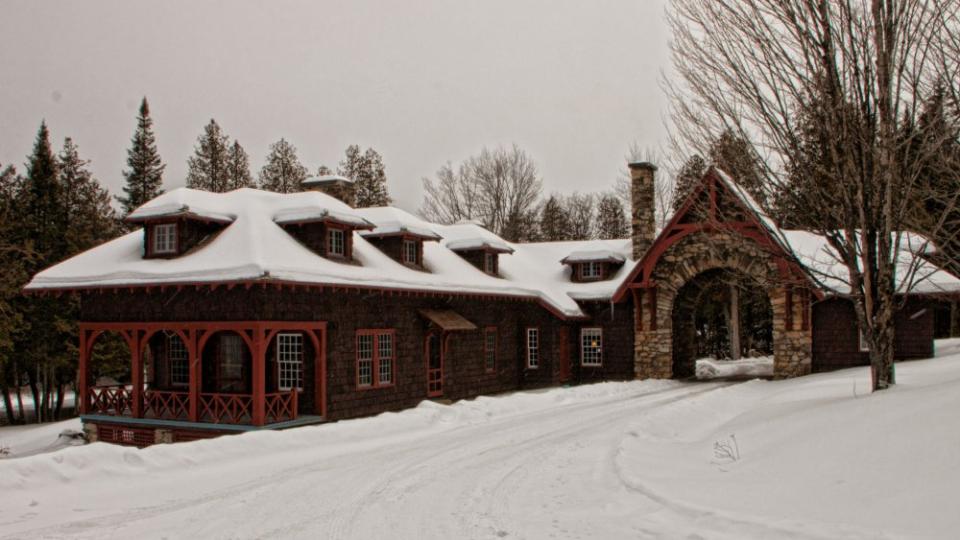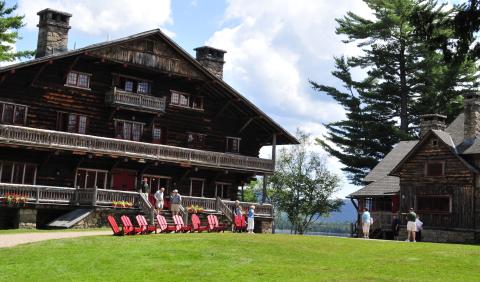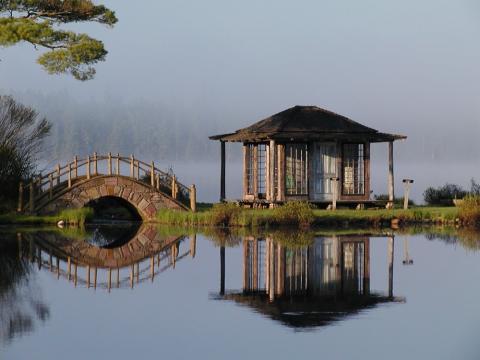Great Camp Pine Knot
Built over a thirteen-year period beginning in 1877 on the shores of Raquette Lake, Camp Pine Knot was the original Adirondack Great Camp and has since epitomized the Great Camp architectural style we know today. Durant designed Camp Pine Knot into a compound cluster of buildings that allowed privacy to coexist with a sense of community. After a long stretch of living lavishly and spending frivolously on the building of Great Camps, William West Durant sold Great Camp Pine Knot to wealthy railroad industrialist Collis P. Huntington in 1895. Huntington passed a few years later, and the camp remained empty for nearly 50 years until his heirs gifted the estate to SUNY Cortland in 1949. Cortland has since renamed the compound Huntington Memorial Outdoor Education Center and hosts school groups year-round.
Great Camp Uncas
Built for his own use and began in 1890, Great Camp Uncas, nestled on the shore of Lake Mohegan, was the second of Durant's Adirondack Great Camps. The camp was composed mainly of resources gathered and forged on-site and was completed in two years. Great Camp Uncas was sold to J. Pierpont Morgan in 1896, who enjoyed it until his passing in 1913. From thereon, the camp remained with the Morgan family until Margaret Emerson, the widow of Alfred Gwynne Vanderbilt, bought the estate in 1947. Mrs. Vanderbilt left Great Camp Uncas to a foundation, which eventually sold it to the Rockland County Boy Scouts. Great Camp Uncas was returned to private use in 1975, and thereafter was listed on the National Register of Historic Places in 1987, and was designated a National Historic Landmark in 2008.
Great Camp Sagamore
Daunting debt did not deter Durant from spearheading the building of his third Adirondack Great Camp, which was destined to be the most expansive and expensive yet. Built over the course of 1895-1897, Great Camp Sagamore was built on the shores of Shedd Lake which sits to the south of Raquette Lake, where Camp Pine Knot and the Adirondack Great Camp style first took root. Great Camp Sagamore was brought to life using the same compound design as Durant's previous two Great Camps. In 1901, Durant fell to more financial hardship as he underwent a lawsuit brought on by his sister over the mismanagement of their family's estate. Great Camp Sagamore was sold to Alfred Gwynne Vanderbilt, who renamed Shedd Lake to Sagamore Lake, and improved the compound to include running water, flush toilets, a sewage system, hydroelectric plant, and an outdoor bowling alley. In 1915, Alfred died as a victim of the Lusitania sinking, leaving Great Camp Sagamore to his widow, Margaret. Margaret used the camp seasonally for years before transferring it to Syracuse University, which operated a conference center on-site. A portion of Camp Sagamore was included on the 1976 National Register of Historic Places, and the camp as a whole was designated a National Historic Landmark in 2000. Currently, the camp is run by the Sagamore Institute of the Adirondacks, which offers accommodations, educational programming, and public guided tours seasonally.


